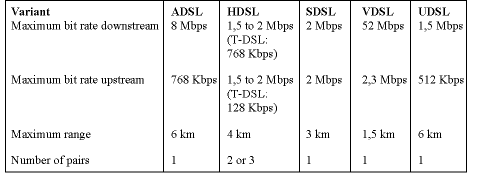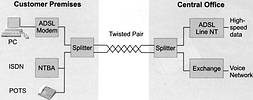
The days when WWW stood for world-wide wait are coming to an end - thanks to deployment of digital subscriber line technology by carriers. Here ADSL, which gives small businesses and private users broadband Internet access at low cost, is emerging as the preferred variant. Not surprisingly, the market for ADSL hardware is growing rapidly.
Progressive upgrading of the backbone network with optical fibre cable has done much to speed up the Internet. Experienced users will have noticed the difference. Only a few years ago, even the faster providers were rarely able to supply data fast enough to use the full capacity of analog modems of the day. The situation has now changed radically. Even an ISDN line with 64 Kbps per B-channel does not provide enough bandwidth to download files without delay. So the bottleneck has shifted from the backbone to the last mile. That calls for new subscriber line transmission technology, of which several variants are available.
Demand for greater bandwidth is being generated by the proliferation of memory-hungry applications. Downloads - whether new browser versions, OS updates or complete application programs - are becoming more and more voluminous. Many websites now offer live streaming of audio and video. Such downloads include interviews with CEOs or MP3 titles for music lovers. But new applications requiring even more bandwidth are increasing. These range from video conferencing through telemedicine and video on demand to interactive games and Internet radio. So the pattern repeats: as soon as enough bandwidth becomes available, it is exhausted by new applications.
DSL technology most promising
Of the various broadband transmission technologies available for the last mile, digital subscriber line (DSL) technology currently offers the greatest prospects. DSL uses ordinary phone lines with twisted copper pairs, installed in almost every home. DSL hardware is available from Siemens and other manufacturers. Epcos offers hardware designers a complete range of components to implement DSL functions. DSL technology is similar to conventional analog transmission with modems in that it uses copper as the transmission medium. But DSL can transmit data at much higher rates because it uses frequencies beyond the telephony spectrum from 300 to 3200 kHz. The modulation technique depends on the DSL variant. DSL has the disadvantage that the range between central office and customer premises equipment is limited - currently 6 km max - so availability depends on the distance between the subscriber and the nearest exchange, and on the equipment installed at the latter.
Digital subscriber line technology is commonly referred to as xDSL because it comes in several variants (Figure 1). At present, ADSL (asymmetric digital subscriber line) technology is by far the most popular and fastest-growing variant. It is called asymmetric because the downstream bandwidth, ie the transmission rate from central office to subscriber, is substantially higher than the upstream bandwidth, ie in the opposite direction. ADSL is ideal for private users and small offices because by far the greater volume of data is transmitted downstream. Here upstream bandwidth requirements, eg for e-mail and FTP, are much smaller.

In Germany, Deutsche Telekom has launched a full-scale campaign to market ADSL under the name T-DSL. Some 850 000 orders have been received and more than 400 000 T-DSL lines installed to date. Deutsche Telekom plans to offer T-DSL coverage for up to 90% of German households by the end of this year.
In a typical configuration (Figure 2), T-DSL is combined with ISDN. Two DSL hardware units are required on customer premises: an ISDN/POTS splitter (BBAE) and an ADSL modem (NTBBA). The telephone line is first connected to the splitter. In the downstream direction, the splitter divides the composite signal from the central office into two frequency ranges. The signals in the lower frequency range are passed via one cable to the ISDN network termination unit (NTBA), which continues to serve ISDN terminals and/or a home telephone exchange. The signals in the higher range are passed via a second cable to an ADSL modem, which is in turn connected by a network cable to an Ethernet card in the PC. In the upstream direction, the splitter combines the various signals. A splitter is also required on the line card in the central office to distribute data and telephony services to the subscriber in the appropriate frequency ranges.

Passive components predominate
Apart from the chipset and purely electromechanical components such as connectors, circuit boards and packages, passive components clearly predominate in ADSL hardware. For the burgeoning ADSL market, Epcos is the one-stop shop for passive components. These can best be classified by functionality. One frequently underestimated but vital function is protection of the entire circuit against destruction by overvoltages, which may be caused by lightning strikes on power lines. Here gas-filled surge arresters with extremely short response times provide primary protection. Epcos is the only manufacturer to offer a hybrid protective component that combines surge arresters with varistors. It protects telecom equipment, both in central offices and on customer premises. This hybrid combines the high current-handling capability of surge arresters with the fast response of SIOV metal oxide varistors. It limits surge transients to acceptable levels of less than 350 V (dv/dt 1 kV/µs), protects against surge currents up to 20 kA (8/20 µs wave) and has a surge life of 400 operations at up to 1000 A (10/700 µs wave).
Transients are limited by the varistors until the gas mixture in the surge arrester has been ionised (typically in less than 0,5 µs) and the arrester can discharge the surge energy to ground. The steepness of the voltage curve (dv/dt) is of no consequence. When the transient has decayed, the hybrid returns to a state of high resistance. Thanks to the hybrid's high insulating resistance and low self-capacitance, the transient has no effect on the system protected. Surge arresters are also available as SMDs.
Primary protection is also provided by PTC thermistors. As the current through a PTC thermistor increases, the component heats up, causing its resistance to rise. This effect can be exploited for a wide variety of protective functions. Epcos offers several series of PTC thermistors for the special needs of the telecom industry. Varistors with unbeatably short response times in the picosecond range provide primary and secondary protection - especially for sensitive semiconductors exposed to overvoltages. For protection of data lines in particular, Epcos has developed dual and quad varistor arrays as SMDs. These provide an economical and space-saving alternative to discrete components. Epcos is the world market leader in gas-filled surge arresters, varistors and PTC thermistors.
Electromagnetic compatibility (EMC) is another important aspect of safety. Like all electrical and electronic products, xDSL hardware must conform to relevant standards for interference-free operation before it can be placed on the market. As a true broadliner, Epcos offers an all-round programme of EMC components. Typical examples are chokes, especially current-compensated chokes for common-mode rejection, which are, of course, available as SMDs as well. Depending on version, they can be designed-in as filters in power supplies or for noise suppression in data lines.
Capacitors are another family of versatile passive components. Tantalum and aluminum electrolytic capacitors from Epcos smooth and buffer DC voltages, for example, and thus prevent voltage fluctuations from causing faults. They are found in power supplies for ADSL hardware as well as on the ADSL line card itself. From late 2001, Epcos will also offer niobium capacitors, which represent a low-cost alternative to tantalum chip capacitors but have three times the volumetric capacitance. Production of tantalum chips in polymer and multi-anode technology is also ramping up. These innovative components feature a significant reduction in equivalent series resistance.
Film capacitors perform two functions in ADSL circuitry: DC decoupling on signal lines and noise suppression. Interference is likewise suppressed by multilayer ceramic capacitors. These components can also be supplied as customer-specific arrays to save board space.
Transformers undoubtedly rank among the key components of ADSL systems. They ensure DC isolation and match impedance to the chipset at the same time. Epcos is equipped for this mass market. The new T57 material for ferrite cores, which is distinguished by high temperature stability and saturation flux density, makes the company one of the top suppliers of transformers. Ferrite materials N92 and N97 were specially developed for transformers in DC/DC converters. They feature a further reduction in losses (N97) and improved saturation properties at high temperatures.
Epcos is the only company to offer a complete range of passive components for ADSL applications from a single source. Many of these components can be modified to customer specific requirements.
| Tel: | +27 11 458 9000 |
| Email: | [email protected] |
| www: | www.electrocomp.co.za |
| Articles: | More information and articles about Electrocomp |

© Technews Publishing (Pty) Ltd | All Rights Reserved